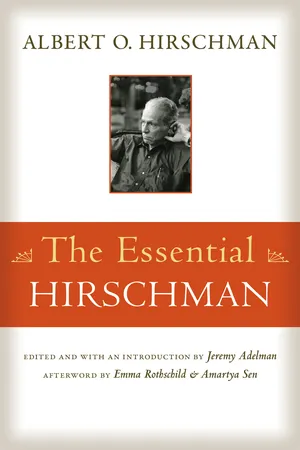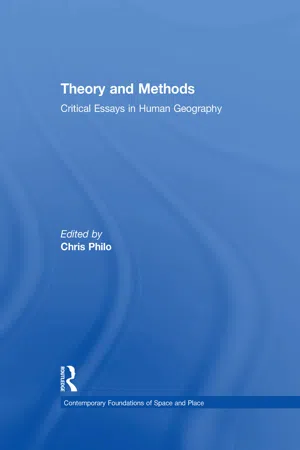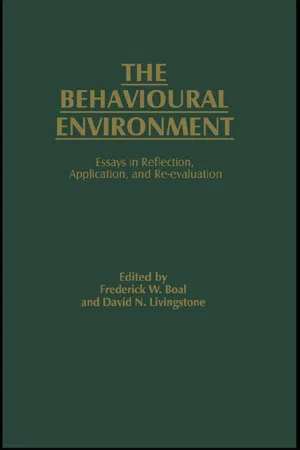Geography
Possibilism
Possibilism is a geographic theory that suggests that the natural environment sets certain constraints or limitations, but human activities are primarily determined by cultural, social, and economic factors. This perspective emphasizes the role of human agency in shaping the environment and rejects environmental determinism, which argues that the physical environment is the primary determinant of human culture and behavior.
Written by Perlego with AI-assistance
Related key terms
Related key terms
1 of 4
Related key terms
1 of 3
3 Key excerpts on "Possibilism"
- eBook - ePub
- Albert O. Hirschman, Jeremy Adelman, Jeremy Adelman(Authors)
- 2013(Publication Date)
- Princeton University Press(Publisher)
This “naive” disregard of sociopolitical realities and of vested interests is precisely rooted in my Possibilism: I propose fundamental changes in institutions such as international aid and investment, but I am not willing to prejudge categorically the extent, much less the modality, of the wider social and political transformations that may or may not be a prerequisite for such proposals ever being adopted. The reason for this agnosticism is in this case the observation that the constraints on policy makers are far less binding in a number of conceivable historical constellations than at “normal” times. Moreover, one important condition for such constellations to yield real change is the prior availability and discussion (followed then, of course, by contemptuous dismissal) of “radical reform” ideas that can be readily picked up when times suddenly cease to be normal.The essays of part III deal in large measure with ideologies and concepts characteristic of the literature on economic and political development and of the intellectual climate in the developing countries. Here I have found an exceptionally good hunting ground for exaggerated notions of absolute obstacles, imaginary dilemmas, and one-way sequences. The essence of the possibilist approach consists in figuring out avenues of escape from such straitjacketing constructs in any individual case that comes up. But to go about this task efficiently it is helpful to be equipped with a few conceptual tools. In the following I shall therefore describe in general terms how I have come to practice “Possibilism,” how I have found it possible to increase the number of ways in which the occurrence of change can be visualized.One handy device is, once again, the notion of blessing (or curse) in disguise. By pointing to the ways in which many presumed “obstacles” to development have in some situations turned into an asset and a spur, one obviously casts doubt on any statements about this or that “obstacle” having to be eliminated if there is to be this or that desirable development.But the notion of “blessing in disguise” is like a label for a certain class of sense data; it has little explanatory value. An intellectually more satisfying, though more specialized, foundation for Possibilism was encountered in the theory of cognitive dissonance. A group of social psychologists has shown through this theory that changes in beliefs, attitudes, and eventually in personality can be entrained by certain actions instead of being a prerequisite to them. This idea is so congenial to my thinking that I pointed to one such “inverted” sequence even before I had become acquainted with Festinger et al.: in many situations, so I argued, the Protestant ethic is not the cause of entrepreneurial behavior, but rather arises as its consequence.29 - eBook - ePub
Theory and Methods
Critical Essays in Human Geography
- Chris Philo(Author)
- 2017(Publication Date)
- Routledge(Publisher)
Abstract . Humanistic geography is often criticized for its weak methodology. I shall argue that pragmatism, a neglected humanistic philosophy, can provide a sound epistemological framework in which to organize and strengthen this methodology. Pragmatism influenced Robert Park, an important figure in the history of urban social geography, whose tentative methodological beginnings can be traced to their more logical exposition in British social anthropology. The development of pragmatic method also proves significant for four related concerns central to human geography. They are the structure-agency debate and the notion of structuration, the ethics of inquiry, the relationship between experience and action, and the tenuous link between intellect and the world of common sense.Key Words : pragmatism, humanistic geography, structure-agency debateHUMANISTIC geographers deserve credit for explicitly examining the movement’s philosophical underpinnings. Much energy has been devoted to clarifying the ontological presuppositions of phenomenology, existentialism, and Marxian humanism, and the undertaking is welcomed by a discipline still smarting from Harvey’s (1973) masterful explosion of the myth of value-free inquiry (see also Pahl 1967). Yet, despite its rich and varied philosophical base, humanistic geography has not yet resolved the thorny epistemological questions that arise in its practice. These questions emerge mainly from attempts to establish the potency of human agency in an unfinished world, and the search for some answers is now a central theoretical concern of social and cultural geography (see Ley 1983). In drawing attention to the prospects for effective action rather than determinacy in social life, the humanist movement faces a central dilemma of contemporary philosophy concerning “the mediation of theory and praxis with regard to an uncertain future” (Apel 1981, 1). Apel has suggested that only three modern philosophies—Marxism, existentialism, and pragmatism—adequately take up the challenge this poses. Although the first two are often explored within geography, pragmatism, a humanistic philosophy in the widest sense,1 remains curiously neglected (but see Frazier 1981; Jackson and Smith 1984).As a philosophy of action grounded in commonplace experience, pragmatism might offer some inspirational guidelines for the practice of humanistic geography. A distinctively North American school of thought nurtured by philosophers, sociologists, and psychologists at the University of Chicago and at Harvard during the early 1900s, it influenced one of the human geography’s best known mentors, Robert Park. This paper develops the epistemological imperatives he drew from his philosophical training, and so finds a basis for humanistic method in the work of the Chicago school of sociology and human ecology. - eBook - ePub
The Behavioural Environment
Essays in Reflection, Application and Re-evaluation
- F.W. Boal, D.N. Livingstone(Authors)
- 2003(Publication Date)
- Routledge(Publisher)
The idea that the environment must be understood in terms of the way people perceived it was a major step forward in human geography. It recognized that it was people’s understanding of environment, not environment itself, that shaped their actions, but it did not elaborate on a means of determining the meaning of the environment itself in the broader context of a society’s priorities and visions of order. A human geography dedicated to investigating human activities or forms of life in their historical contexts seeks to establish a broader basis for understanding the character of human activities on the surface of the earth and their connections to the physical environment.Acknowledgement
I am grateful to my colleagues Jean Andrey, Roy Officer, and Peter Nash for their critical comments on an earlier draft of this chapter. The responsibility for the ideas expressed herein remains entirely mine.Notes
1 This integration of physical and human geography is typified in the work of such environmental determinists as Ellsworth Huntington, Griffith Taylor, and Ellen Churchill Semple.2 G.Tatham, ‘Environmentalism and Possibilism’, in G.Taylor (ed.), Geography in the Twentieth Century, 3rd edn (Methuen, London, 1953), pp. 128–62.3 C.O.Sauer, ‘The morphology of landscape’, University of California Publications in Geography no. 2 (1925), University of California, Berkeley, pp. 19–54; J.K.Wright, ‘Terrae incognitae: the place of the imagination in geography’, Annals of the Association of American Geographers, vol. 37 (1947), pp. 1–15; W.Kirk, ‘Historical geography and the concept of the behavioural environment’, Indian Geographical Journal, Silver Jubilee Volume (1952), pp. 152–60.4 Kirk, ‘Historical geography and the concept of the behavioural environment’, p. 159.5 For example, T.F.Saarinen, ‘Perception of the drought hazard on the Great Plains’, Research Paper no. 106 (1966), Department of Geography, University of Chicago; and P.Gould and R.White, Mental Maps
Index pages curate the most relevant extracts from our library of academic textbooks. They’ve been created using an in-house natural language model (NLM), each adding context and meaning to key research topics.
Explore more topic indexes
Explore more topic indexes
1 of 6
Explore more topic indexes
1 of 4


